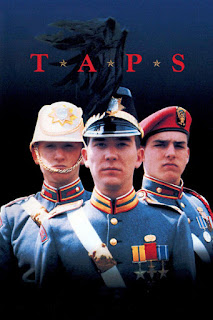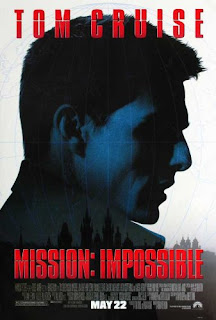The Color of Money (1986)
While filming Top Gun, Tom Cruise received an offer to work with yet another critically acclaimed director. This time, it was Martin Scorsese, and the project was the 1986 movie The Color of Money, a sequel to the 1961 film The Hustler with Paul Newman reprising the title character. Although the film is a solid enough endeavor, it doesn't get close to recapturing the critical acclaim of its predecessor.
That's not to say that this film is bad. After all, a bad film helmed by a director with a reputation like Scorsese is an unlikelihood. However, it does stick out from the rest of his filmography, just because it's not as inspired as his other works. This makes sense, given that Scorsese claims he only took over at the request of Paul Newman and as a way to prove that he could make a commercially successful film (a goal that feels laughable in 2020 after films like Goodfellas and The Wolf of Wall Street).
Admittedly, I still haven't seen The Hustler, so perhaps any criticism I have on this film is not nearly as informed as it could be. However, as a consequence of this film, I'm at least somewhat familiar with the plots of The Hustler and the novels which both films are based on. With that in mind, I am comfortable saying that the biggest failure of The Color of Money is that it follows a similar formula to The Hustler, only Eddie is now the teacher instead of the student, and the emotional stakes of the characters' lives are much, much lower.
The end result is something that's very competently made, but without much to really pull apart. There's nothing really bad about it, per sey, but it lacks the richness found in so many Scorsese films. The characters have their flaws, and lessons are learned, but there's little present to actually motivate any in-depth emotional involvement.
The most interesting parts of this film to me is, of course, Cruise's part. It's purely coincidental that Vincent Lauria is essentially the hustler version of Maverick, but The Color of Money officially continues the trend of Cruise's tendency to play cocky characters. And, as the last movie that Cruise filmed before joining the Church of Scientology, it also set into gear a blueprint of Cruise's future identity solidified within the Church and turned into a trademark of his career.
The Color of Money is also the first time Cruise demonstrates that he can hold his own against acting giants like Paul Newman in a serious adult film. Although this movie often goes unmentioned in the broader conversation of his career, it's also the glimpse into the full extent of Cruise's acting talent -- something that's unfortunately been overlooked in modern discussions about him in favor of his stunt work. Which, coincidentally, is another interesting tidbit about this film: Cruise performed all his own pool shots with the exception of a jump shot. In addition, Paul Newman, with whom Cruise is reported to have had a very good relationship, introduced him to the world of car racing behind the scenes, completing the trifecta of Cruise's love for manning planes, motorcycles, and cars.
Unfortunately, there's not much else to say about The Color of Money. This movie is known for being the only Scorsese project that received a negative review from Roger Ebert. Within the broader context of Scorsese's career, it's not too difficult to understand why. It's more of a film to have on in the background than to actively watch.
Rating: 3.35/5 - February 17, 2020
That's not to say that this film is bad. After all, a bad film helmed by a director with a reputation like Scorsese is an unlikelihood. However, it does stick out from the rest of his filmography, just because it's not as inspired as his other works. This makes sense, given that Scorsese claims he only took over at the request of Paul Newman and as a way to prove that he could make a commercially successful film (a goal that feels laughable in 2020 after films like Goodfellas and The Wolf of Wall Street).
Admittedly, I still haven't seen The Hustler, so perhaps any criticism I have on this film is not nearly as informed as it could be. However, as a consequence of this film, I'm at least somewhat familiar with the plots of The Hustler and the novels which both films are based on. With that in mind, I am comfortable saying that the biggest failure of The Color of Money is that it follows a similar formula to The Hustler, only Eddie is now the teacher instead of the student, and the emotional stakes of the characters' lives are much, much lower.
The end result is something that's very competently made, but without much to really pull apart. There's nothing really bad about it, per sey, but it lacks the richness found in so many Scorsese films. The characters have their flaws, and lessons are learned, but there's little present to actually motivate any in-depth emotional involvement.
The Color of Money is also the first time Cruise demonstrates that he can hold his own against acting giants like Paul Newman in a serious adult film. Although this movie often goes unmentioned in the broader conversation of his career, it's also the glimpse into the full extent of Cruise's acting talent -- something that's unfortunately been overlooked in modern discussions about him in favor of his stunt work. Which, coincidentally, is another interesting tidbit about this film: Cruise performed all his own pool shots with the exception of a jump shot. In addition, Paul Newman, with whom Cruise is reported to have had a very good relationship, introduced him to the world of car racing behind the scenes, completing the trifecta of Cruise's love for manning planes, motorcycles, and cars.
Unfortunately, there's not much else to say about The Color of Money. This movie is known for being the only Scorsese project that received a negative review from Roger Ebert. Within the broader context of Scorsese's career, it's not too difficult to understand why. It's more of a film to have on in the background than to actively watch.
Rating: 3.35/5 - February 17, 2020





Comments
Post a Comment